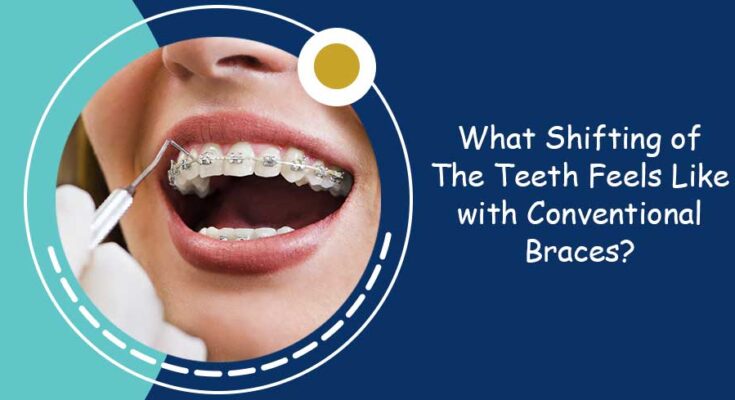Conventional braces are a tried and tested way to straighten the teeth. Straightened teeth not only look aesthetically more appealing but also work with greater efficiency in biting down and chew food properly. This in turn facilitates better assimilation. Braces also contribute to the long-term health of the teeth and the gums. Braces are good at spreading your biting pressure across the mouth and this makes eating easier.
When you know what to expect from orthodontic braces you automatically become readier to have the first-hand experience of life with braces. The procedure itself is quite simple. As a patient, you do not have any role in it other than sitting back and relaxing while your orthodontist performs the spadework. First, the braces need to be placed properly.
Placing the braces properly
Before placing the braces, the orthodontist will work on your teeth to prepare their surface. This preparatory work helps to attach the brackets to the teeth. Dental glue is used to hold the brackets to the teeth. The glue contains a high percentage of fluoride, the substance that eliminates harmful bacteria in the mouth that cause tooth cavities.
Once the brackets are placed the wire is inserted through the bracket slots. The wire actually moves or shifts the teeth. Teeth movement starts the moment the wire is activated although you will not feel the movement at this stage.
What orthodontic braces make you feel?
When you visit your orthodontist for the placement appointment, the metal edges of the brackets will touch your tongue and the cheeks. This factor will automatically get resolved in a few days. Only after few hours have passed after placement of the braces do you start getting the feeling that the teeth are moving. How is that feeling exactly? Well, it is somewhat like you did not work out for days together and then suddenly drop in at the gym to do some exercise. The way your muscles feel the next day – a little sore and tender – is exactly how you feel with the braces on initially.
Usually, the soreness of the teeth does not linger beyond a few days. Since the perception of soreness varies from person to person, some people could be in more discomfort than others during these initial few days with the braces. A bit of time is all anyone needs at this stage to get used to the feeling. Your teeth never shifted before and this is the first-ever attempt to shift them from their natural positions. As a result, the feeling of discomfort id pretty natural. In worse case situations you can have painkillers that are available over the counter at chemist shops. Those medicines are helpful in reducing both pain and soreness. You are likely to be in need of dental wax to apply in the areas of the tongue and the cheeks where the braces rub against.
The teeth get loose
A few days after you start your journey with braces the teeth start moving. At this stage, you may feel and even notice few teeth getting loose from their sockets. There is nothing to panic about this. This is the natural phenomenon of teeth movement. While shifting the teeth have to move through the bones. That is why you feel they are loosening out. Moreover, at this stage, you will discover open spaces around the teeth that never existed before. But as the teeth shift to their optimal positions, those open spaces vanish away and the teeth feel firm again just like before.
Taking care of your braces
Right after placing the braces on the teeth, your orthodontist will give, you care instructions for the braces. Remember that in conventional orthodontic teeth straightening treatment is desired and satisfactory results depend on how better care of the teeth as well as the brackets you took. You have to stick to those instructions closely for successful results.
Brushing
While your life is on braces it is of utmost importance to ensure that your teeth, gums, and the brackets themselves are consistently clean. So, need to chip in extra effort in brushing and flossing the teeth. Brush the teeth every time after a meal with a toothbrush with soft bristles. Hole the toothbrush at an angle of 45 degrees with the teeth and brush gently above, below, and even between the brackets. Clean the tongue and roof of the mouth too. Make sure there is no trapped food particle in or around the teeth. Replace the brush with a new one as soon as the bristles start looking dull and a little spread out. If you want to invest money then go for an electric toothbrush at this stage. Those toothbrushes perform better in keeping the mouth free of plaques than manual toothbrushes.
Flossing
Flossing is a tried and tested phenomenon to get rid of plaque build-ups and trapped food particles between the teeth as well as the braces. Flossing at least once daily is crucial while you are on braces. Ask the orthodontist to show you the correct flossing method while wearing braces on the teeth. It is relevant mentioning healthy teeth and gums shift more easily which in turn ensures your treatment is going on the right track.
Rinse with mouthwash
At this stage, it is crucial avoiding plaque build-up in the mouth. Rinse the mouth well several times a day with an antibacterial mouthwash. This furthermore helps reducing irritation as well as minor inflammation of the gums.
Eating with braces
Plaque build-up and collection of food debris are both natural phenomena that affect the teeth whether you are or you are not on braces. But the metal brackets prove to be a wonderful tool for both plaques and food debris to settle themselves on the surface of your teeth. Dentists dealing in invisalign braces in London warn while you are on braces your teeth are most susceptible to tooth decay and gum infection.
To avoid this flip side, it is better to avoid certain foods. These include foods and drinks with a high percentage of sugar, sticky and chewy foods. It is even advisable to avoid fizzy drinks at this stage. The carbonated drinks can wear out the glue that attaches the braces to the teeth.


